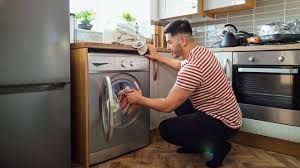Appliance Repair Tips for Refrigerators, Dryers, and Washers
Appliances are essential components of modern living, providing convenience and efficiency in daily household tasks. However, they are prone to wear and tear over time. When your refrigerator, dryer, or washer malfunctions, it can be both frustrating and costly. This article offers practical tips for diagnosing and repairing common issues with these appliances, helping you save money and extend their lifespan.
Refrigerator Repair Tips
1. Temperature Issues
One of the most common problems with refrigerators is improper temperature regulation. Here’s how to address it:
- Check the Thermostat: Ensure the thermostat is set to the correct temperature. For most refrigerators, the ideal temperature is around 37°F (3°C) and the freezer should be at 0°F (-18°C).
- Clean the Condenser Coils: Dust and debris can accumulate on the condenser coils, causing the fridge to work harder and less efficiently. Unplug the refrigerator, locate the coils (usually at the back or beneath the unit), and clean them with a vacuum or brush.
- Inspect the Door Seals: Worn or damaged door seals can let warm air in, causing the fridge to run constantly. Close the door on a dollar bill; if it slips out easily, the seal needs replacing.
2. Refrigerator Not Running
If your refrigerator isn’t running at all, the issue could be electrical or mechanical:
- Check the Power Source: Ensure the refrigerator is plugged in and that the outlet is working. You can test the outlet by plugging in another appliance.
- Inspect the Circuit Breaker: Sometimes, a tripped circuit breaker can cause power issues. Reset the breaker if necessary.
- Examine the Compressor: If the fridge is getting power but not running, the compressor could be the problem. Listen for a humming sound from the back of the fridge; if you don’t hear it, the compressor may need professional attention.
3. Water Leaks
Water leaks can damage your kitchen floor and lead to mold growth. Here’s how to troubleshoot:
- Check the Drain Pan: The drain pan collects water from the defrost cycle. If it’s cracked or improperly positioned, it can cause leaks.
- Inspect the Water Line: For refrigerators with water dispensers or ice makers, ensure the water line is secure and not damaged.
- Unclog the Defrost Drain: A clogged defrost drain can cause water to overflow and leak. Use a mixture of baking soda and warm water to clear any blockages.
Dryer Repair Tips
1. Dryer Not Heating
If your dryer is running but not producing heat, several components could be at fault:
- Check the Thermal Fuse: The thermal fuse is a safety device that prevents the dryer from overheating. If it’s blown, the dryer won’t heat. Use a multimeter to test the fuse for continuity and replace it if necessary.
- Inspect the Heating Element: The heating element generates the heat for drying clothes. If it’s broken or burned out, it needs replacing. Test it with a multimeter for continuity.
- Examine the Thermostat: The high-limit thermostat regulates the dryer’s temperature. If it’s faulty, the dryer may not heat properly. Replace it if it’s not functioning correctly.
2. Dryer Drum Not Spinning
A dryer drum that doesn’t spin can’t dry clothes efficiently. Here’s what to check:
- Broken Drive Belt: The drive belt connects the motor to the drum, enabling it to spin. If the belt is broken or slipped off, replace it.
- Faulty Drum Rollers: Drum rollers support the drum and allow it to rotate smoothly. Worn-out rollers can cause the drum to stop spinning. Inspect and replace them if needed.
- Malfunctioning Motor: If the motor is defective, it won’t turn the drum. Listen for a humming sound when you start the dryer; if you hear it but the drum doesn’t spin, the motor may need replacement.
3. Dryer Making Unusual Noises
Strange noises coming from your dryer can indicate several issues:
- Loose or Worn Belt: A loose or worn belt can cause thumping or squeaking noises. Inspect and replace it if necessary.
- Damaged Drum Bearings: Drum bearings support the drum’s rotation. If they’re worn or damaged, they can produce grinding or squealing noises. Replace the bearings if needed.
- Foreign Objects: Sometimes, items like coins or buttons can get trapped in the drum or blower wheel, causing noise. Inspect the drum and remove any foreign objects.
Washer Repair Tips
1. Washer Not Draining
If your washer isn’t draining properly, it can leave clothes soaking wet. Here’s how to fix it:
- Check the Drain Hose: Ensure the drain hose is not kinked or clogged. Remove any blockages and make sure the hose is properly positioned.
- Inspect the Pump: The drain pump removes water from the washer. If it’s clogged or malfunctioning, the washer won’t drain. Clean the pump filter and replace the pump if necessary.
- Examine the Lid Switch: The lid switch prevents the washer from spinning when the lid is open. If it’s faulty, the washer may not drain. Test the switch for continuity and replace it if needed.
2. Washer Not Spinning
A washer that doesn’t spin can leave clothes wet and heavy. Here’s what to check:
- Balance the Load: An unbalanced load can prevent the washer from spinning. Redistribute the clothes evenly and try again.
- Check the Drive Belt: The drive belt connects the motor to the drum. If it’s broken or slipped off, the washer won’t spin. Inspect and replace the belt if necessary.
- Inspect the Motor Coupling: The motor coupling connects the motor to the transmission. If it’s worn or broken, the washer won’t spin. Replace the coupling if needed.
3. Washer Leaking Water
Water leaks from your washer can cause significant damage to your laundry area. Here’s how to troubleshoot:
- Check the Hoses: Inspect the fill hoses and drain hose for cracks, loose connections, or blockages. Replace or tighten them as needed.
- Examine the Door Seal: For front-loading washers, the door seal can wear out over time, causing leaks. Inspect the seal for tears or damage and replace it if necessary.
- Inspect the Pump: The pump and its connections can also be sources of leaks. Check for any signs of damage or loose connections and repair or replace the pump if needed.
4. Washer Making Unusual Noises
Unusual noises from your washer can indicate underlying problems:
- Foreign Objects: Items like coins or small clothing articles can get trapped in the drum or pump, causing noise. Inspect and remove any foreign objects.
- Worn Bearings: Drum bearings allow the drum to rotate smoothly. If they’re worn, they can produce loud noises. Replace the bearings if needed.
- Loose Drum: A loose drum can cause banging noises during the spin cycle. Ensure the drum is securely fastened and adjust any loose parts.
General Maintenance Tips
1. Regular Cleaning
Regular cleaning can prevent many common issues and extend the life of your appliances:
- Clean Lint Traps: For dryers, clean the lint trap after every use to prevent fire hazards and improve efficiency.
- Wipe Seals and Gaskets: Regularly wipe down the seals and gaskets on refrigerators and washers to prevent mold and mildew buildup.
- Descale and Deodorize: Use descaling agents for washers and vinegar solutions for refrigerators to keep them running smoothly and smelling fresh.
2. Schedule Professional Inspections
While many repairs can be done by homeowners, scheduling regular professional inspections can catch potential issues before they become major problems. Annual maintenance checks can ensure your appliances are in good working order.
3. Use Appliances Properly
Using your appliances according to the manufacturer’s instructions can prevent many common issues:
- Avoid Overloading: Don’t overload your washer or dryer, as this can strain the motor and other components.
- Properly Position Appliances: Ensure your refrigerator has adequate ventilation and is level to prevent mechanical issues.
Appliances Running Smoothly
Maintaining and repairing your refrigerator, dryer, and washer can save you money and extend their lifespan. By following these tips and performing regular maintenance, you can address common issues and keep your appliances running smoothly. For more complex problems, don’t hesitate to seek professional assistance to ensure your appliances are safely and effectively repaired.




